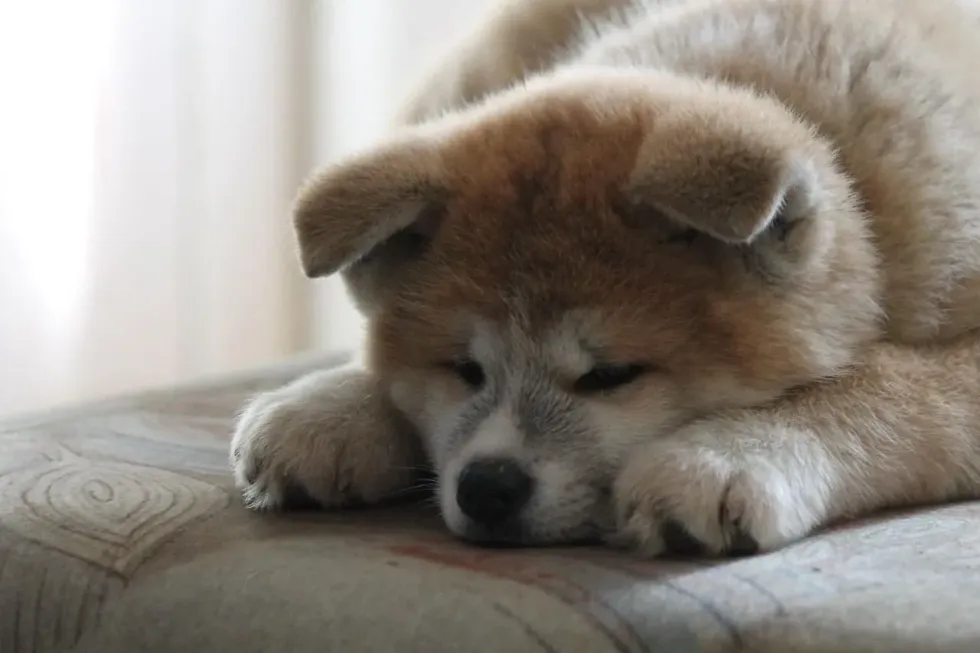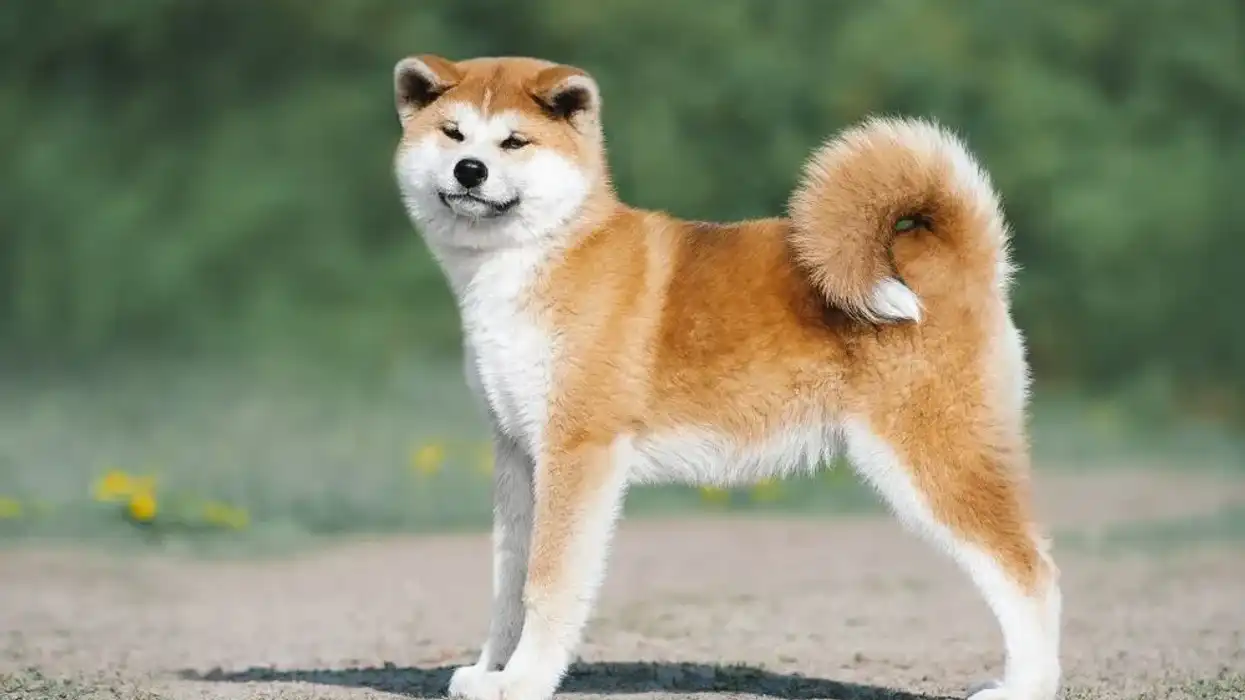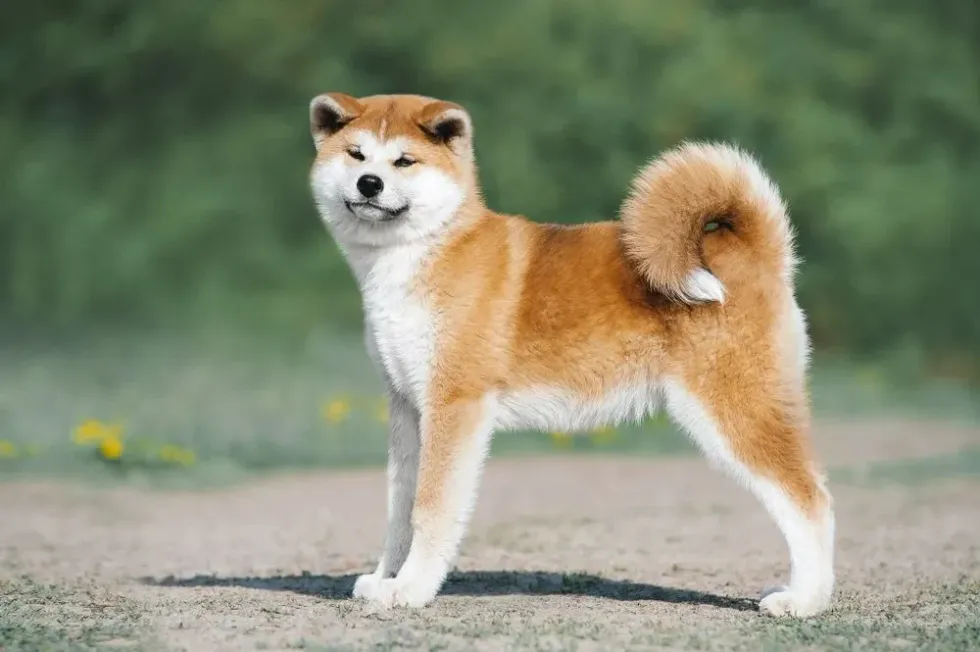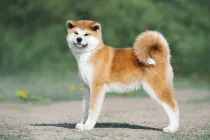Fun Akita Inu Facts For Kids

Content
- What type of animal is an Akita Inu?
- What class of animal does an Akita Inu belong to?
- How many Akita Inus are there in the world?
- Where does an Akita Inu live?
- What is an Akita Inu's habitat?
- Who do Akita Inus live with?
- How long does an Akita Inu live?
- How do they reproduce?
- What is their conservation status?
- What do Akita Inus look like?
- How cute are they?
- How do they communicate?
- How big is an Akita Inu?
- How fast can an Akita Inu run?
- How much does an Akita Inu weigh?
- What are the male and female names of the species?
- What would you call a baby Akita Inu?
- What do they eat?
- Are they slobbery?
- Would they make a good pet?
- Did you know...
- Keeping Akita Inus
- History Of The Akita Inu
Akita Inu, or the Japanese Akita, is a breed of dog that comes from the northern mountainous regions of Japan. This breed was bestowed with the title of ‘natural treasure’ by the Japanese government in 1931 for their hard work and loyalty.
This furry, double-coated, fiercely loyal, and independent dog is often employed for hunting, police work, guarding, and fighting. But, they are mostly just kept as pets in homes.
The breed name has significance. The word 'inu' means dog in Japanese. The name Akita comes from the capital city of the Akita Prefecture located in the Honshu Island of northern Japan. This is the region where these dogs originated.
Akita breeds are large, powerful, and muscular. They have broad heads with small, erect, and pointed ears. Japanese Akitas have large, bushy, and curved tails.
People often confuse Akita Inus and Shiba Inus, but they are two separate dog breeds. Akita vs Shiba Inu is an easy comparison to make, this is because Akita Inus are a large breed and Shiba Inu falls into the small to medium category of dogs.
Both are spitz-breed dogs hailing from Japan. There is another major difference in the jobs performed by Shiba Inu vs Akita Inu. The larger Akita Inus employed hunting games such as bears, wild boar, and elk.
Smaller Shiba Inus flushed out the smaller game from forests. This breed is now the most well-liked companion dog in Japan.
If you enjoyed reading these facts about Akita Inus, check out the fact files on Shiba Inu and Australian Shepherd.
Akita Inu Interesting Facts
What type of animal is an Akita Inu?
Akita Inus are a native dog breed from Japan.
What class of animal does an Akita Inu belong to?
Akita Inus are mammals like all other dogs.
How many Akita Inus are there in the world?
It is difficult to gauge the exact number of Akita Inus in the world. They are found globally and it is thought that there is an abundance of this breed.
Where does an Akita Inu live?
Japanese Akita Inus originate from the Akita prefecture, in northern Japan. Their ancestors were wild and lived in forested areas. They were then tamed and bred to guard Japanese royalty. In modern times, Akitas live in homes with their owners.
What is an Akita Inu's habitat?
Akita Inus is a Japanese dog breed that is more comfortable in colder weather than in hot weather. This is due to their thick double coat. The cold weather tolerance of Akitas allows them to survive in snowy weather.
Who do Akita Inus live with?
Japanese Akita dogs were bred to be lone workers. They are fiercely independent and strong-willed dogs. These dogs are not very social with other dogs or pets and may get involved in occasional fights.
However, they make extremely loyal pets and can act as a guardian of the house. This breed is affectionate and protects their families. They follow their owners, listen to their commands and seek their attention. If properly trained and socialized from an early age, Akitas can live with other dogs too.
However, taking a Japanese Akita to a dog park for their daily regular exercise may not be a good idea. Jogging or brisk walking with their owner, or running in their backyard, maybe the best way to keep an Akita fit.
How long does an Akita Inu live?
Japanese Akita Inus may live for between ten to 15 years.
How do they reproduce?
Akita Inus reproduce sexually. The female dogs give birth to between three and 12 puppies at a time.
What is their conservation status?
The conservation status of Akita Inus is Least Concern.
Akita Inu Fun Facts
What do Akita Inus look like?
Japanese Akita dogs have a majestic appearance. Their coat colors are usually red (aka), white (shirio), silver (gin), black (kuro), and sesame (goma iro).
These dogs are well-known for their urajiro, or the dog breeds typical visibility of whitish hair in some parts of the body. These are usually seen on the muzzle, cheeks, tail, underside of the jaws, body, chest, and the inner side of the legs.
Most Akitas have a distinct mask that is easily recognizable. Japanese Akitas mostly have a red or white mask and American Akitas have a black mask around the muzzle. Japanese Akitas have small, deep-set eyes and small, pointy, triangular ears.
Akita Inus are large dogs. Male dogs can grow as tall as 27 in (68 cm). Akitas have three types of hair in their double coat.
This includes the outer coat which guards the inner coat. The outer coat is short or medium and stands out like soft needles. Then, there is the coarse regular coat. This shields the Akitas body against water, weather, and injuries.
The undercoat is fine and wooly, this soft, extra thick, dense coat of fine hair keeps the Akita dogs warm in extremely cold weather. In summer, these dogs shed hair from their double coats to bear the summer heat. The curly Akita tail looks very cute indeed.
Though Akita Inu dogs shed moderately throughout the year, their main shedding only happens twice. Regular grooming can help to reduce this shedding.

How cute are they?
Akita Inus are large and furry dogs. Akitas are often considered to be aggressive. This working dog breed assisted in hunting, as well as guarding Japanese nobility. For their owners, Akita dogs are very cute and they love to cuddle.
However, Akitas may be wary of strangers and other dogs of the same sex. Akita Inus sometimes have an intimidating presence that can scare guests and strangers. Akita Inus are a native Japanese dog breed, whereas American Akitas also have Western dog genes.
How do they communicate?
Akitas do not bark without reason. These dogs communicate in many ways and may even mumble or grunt to talk to their owners. These highly intelligent dogs listen well to commands and perform well in dog sports, but they can be stubborn at times. Akita dogs may consider staring or prolonged eye contact as a challenge.
How big is an Akita Inu?
Compared to Pomeranians, which are about 8 in (20 cm) in height, and 6 lb (2 kg) in weight, Akita Inus are more than three times taller and 12 times heavier.
How fast can an Akita Inu run?
Akita Inus are an athletic, working dog breed. They can run as fast as 1.25 mph (2 kph).
Despite having enough energy to run a lot, Akitas get bored quickly and may not enjoy running for a long time in one stretch. Due to their double-coated fur, these dogs run better in colder weather than they do in warm weather.
How much does an Akita Inu weigh?
Japanese Akita Inus are large dogs. The male dogs weigh between 70.5–86 lb (32–39 kg). Female Akita Inus can weigh 51-64 lb (23-29 kg).
What are the male and female names of the species?
Male Akita Inus are called dogs and female Akita Inus are called bitches.
What would you call a baby Akita Inu?
A baby Akita Inu is called a puppy.
What do they eat?
Traditionally, the diet of Akita Inu puppies included rice, fish, and sea plants. These big dogs need a nutrient-rich and balanced diet to stay healthy.
An Akita's ideal diet should include premium puppy food for at least four months. They can then be given dry food or home-cooked food. Meat, rice, and vegetables are a major part of a Japanese Akitas diet.
How much or how frequently an Akita should be fed completely depends on the dog's age, size, health condition, and activity level. Most Akitas need to be fed twice a day.
Are they slobbery?
Akitas are moderate droolers. They may drool when they are excited, hungry, or for various other reasons.
Would they make a good pet?
Japanese Akitas make wonderful pets for owners who don't have any other pets. This is because Akita Inus aren't too tolerant towards other dogs or smaller animals. They are sweet, loyal, and protective towards their families but may be aloof towards strangers and guests.
They are happy around their family members and need regular exercise. Regular brushing with a bristle brush is enough to maintain this double-coated dog. Their nails need trimming and their ears need to be checked regularly for any redness or infection.
Akitas are very clean dogs. They clean themselves in a cat-like fashion and some even lick clean their mouth after eating.
Owners who wish to keep an Akita have a choice between an American Akita and a Japanese Akita. The American Kennel Club has separate breed standards for these dogs as they consider them to be separate breeds. Akita Inus can tolerate cold temperatures and moderate weather.
They can thrive in countries with moderate climates such as New Zealand, and also in colder parts of northern countries. Akitas are generally a healthy dog breed but they may suffer from health issues like sebaceous adenitis (a genetic skin condition), hip dysplasia, bloating, and hypothyroidism.
Did you know...
Japanese Akita dogs have existed since the 1600s and are a purebred dog breed. The fame of Japanese Akitas did not stop with the legendary dog Hachikō, who waited at the train station for ten years for his owner to return.
Famous Hollywood movies have been made featuring this dog breed. The film ‘Hachi: A Dog’s Tale’ featuring Richard Gere, was based on Hachiko's life.
This dog breed had an average lifespan of 14 to 15 years before World War II which ended up reducing their lifespan. During World War II this dog breed almost became Extinct due to food scarcity and diseases.
They are a trusted and respected dog breed in Japan, and many mothers leave their young babies under the care of their pet Akita Inus. A statue of an Akita is gifted when a child is born in Japan as a mark of good health, long life, and happiness.
In memory of Hachiko, a statue of an Akita was erected in front of Japan's Shibuya train station. The first Akita to come to America was called Kamikaze Go.
This dog was gifted to Helen Keller by the Japanese government when she visited the country. Unfortunately, Kamikaze Go died after a few months and his sibling Kenzan-Go was sent to Helen Keller from Japan. Many Japanese Akita puppies were brought to the US by American soldiers who were stationed in Japan.
Originally, Akita dogs had floppy ears like Hachiko, but the popularity of dog fights and dog sports led to the cross-breeding of several big dog breeds that resulted in the short, erect, and triangular ears of modern Akita Inu dogs.
Although they are of Japanese origin, Akita Inus are as popular as American Staffordshire Terriers among dog owners in the United States. Akita Inus also take part in several dog sports. Akitas excel in agility, obedience, carting, tracking, sledding, and some other dog sports.
Keeping Akita Inus
The strong-willed Japanese Akita Inus were meant to work solo. Japanese people originally bred them as hunting dogs that could work alone and make decisions.
The stubbornness of this dog can be attributed to this. Akitas are not very social and are not the type to enjoy being hugged by everyone they meet.
They are rather reserved in nature but are extremely loyal to their owners. Akita Inu puppies may also land themselves in fights with other dogs to guard their family and protect their pride. They are often misunderstood dogs because of their strong-willed, stubborn, and reserved nature.
With love, care, attention, and training, Akita Inu puppies can be as good a pet as any big dog. Akita Inu breeds are banned in many cities in the USA that consider their aggressive dogs.
Japanese Akitas are one of the most expensive dog breeds in the USA. Japanese Akita Inu puppies can cost around 4,500. USD.
Purebred Japanese Akitas are more expensive compared to American Akita breeds which can cost around 800 to 1,200 USD. American Akitas can be recognized mostly from their black mask, which the Japanese breed does not have. Akita Inus are available through kennel clubs, reputable breeders, or shelters.
History Of The Akita Inu
Japanese Akita dog breeds have a long history. These wild dogs that were living in the mountainous regions of the Akita prefecture, in northwestern Japan were tamed to protect Japanese royalty.
They were working dogs that aided in hunting by flushing out big game like elk, small bears, and wild boar from the snowy mountains. The fascination with dog-fighting resulted in the cross-breeding of Akitas with various European breeds. This increased the size of the dogs and changed the shape of the ears, eyes, and tail.
During World War II, this dog breed faced Extinction, but some loyal Akita lovers preserved the breed with all their might. The first Akita, Kamikaze Go, arrived in the US with Helen Keller.
Here at Kidadl, we have carefully created lots of interesting family-friendly animal facts for everyone to discover! Learn more about some other mammals including boxer bulldog mix, or petit basset griffon vendeen.
You can even occupy yourself at home by drawing one of our Akita Inu coloring pages.
We Want Your Photos!
More for You
See All
Bachelors in Business Administration

Aashita DhingraBachelors in Business Administration
Based in Lucknow, India, Aashita is a skilled content creator with experience crafting study guides for high school-aged kids. Her education includes a degree in Business Administration from St. Mary's Convent Inter College, which she leverages to bring a unique perspective to her work. Aashita's passion for writing and education is evident in her ability to craft engaging content.
Bachelor of Law

Abdulqudus MojeedBachelor of Law
A versatile professional with a passion for creative writing and technology. Abdulqudus is currently pursuing his Bachelor of Law from the University of Lagos and has experience as a tutor, intern assistant, and volunteer. He possesses strong organizational skills and is a detail-oriented person.
Disclaimer
1) Kidadl is independent and to make our service free to you the reader we are supported by advertising. We hope you love our recommendations for products and services! What we suggest is selected independently by the Kidadl team. If you purchase using the Buy Now button we may earn a small commission. This does not influence our choices. Prices are correct and items are available at the time the article was published but we cannot guarantee that on the time of reading. Please note that Kidadl is a participant in the Amazon Services LLC Associates Program, an affiliate advertising program designed to provide a means for sites to earn advertising fees by advertising and linking to Amazon. We also link to other websites, but are not responsible for their content.
2) At Kidadl, we strive to recommend the very best activities and events. We will always aim to give you accurate information at the date of publication - however, information does change, so it’s important you do your own research, double-check and make the decision that is right for your family. We recognise that not all activities and ideas are appropriate for all children and families or in all circumstances. Our recommended activities are based on age but these are a guide. We recommend that these ideas are used as inspiration, that ideas are undertaken with appropriate adult supervision, and that each adult uses their own discretion and knowledge of their children to consider the safety and suitability. Kidadl cannot accept liability for the execution of these ideas, and parental supervision is advised at all times, as safety is paramount. Anyone using the information provided by Kidadl does so at their own risk and we can not accept liability if things go wrong.
3) Because we are an educational resource, we have quotes and facts about a range of historical and modern figures. We do not endorse the actions of or rhetoric of all the people included in these collections, but we think they are important for growing minds to learn about under the guidance of parents or guardians.







